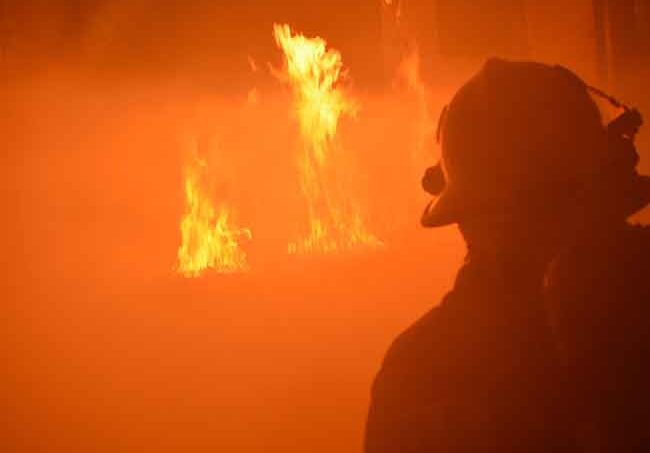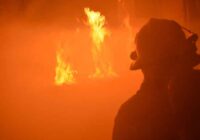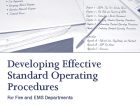
Features
Codes and standards
Hot topics
Developing SOPs
February 2016 - In our fire departments, we throw around terms such as leadership, accountability and management. Why do these terms matter and why do we always talk about them?
February 12, 2016
By Jay Shaw

The answer is as simple as it is complicated: fire departments and firefighters require a foundational system of governance to guide what and how they do everything from wash the trucks to rescuing a downed colleague. There has to be rule and order. Without rule and order, we would have no one to lead, nothing to manage and no accountability.
Your department’s governance system comprises two key foundations: the hierarchical structure of order, which is how your department classifies its ranks of personnel and the reporting system that makes up your core organization (think of this as the hardware or physical structure); and the rules or directives that tell you how to operate inside of the organization – the software. For simplification, think about all the apparatuses, SCBAs, tools and equipment as things to manage; the people who do the work – the managing – are led by a rank-and-order structure. We want to lead people and manage things.
First we need the hardware; this is the all-encompassing process of linking the mission, vision and value statements of our fire services with the strategic master plan and the vision for the city or municipality. All these processes and lines on an organizational chart can sometimes cause confusion and we tend to forget or disassociate the weight and levels of importance that they carry. Never forget that first and foremost, you work for an elected government, then the fire department, then the division of operations, for example.
The software – the actual procedures, guidelines, policies and rules – tell you how to do the actual work that you do. These directives generally concern firefighters the most, but those who fail to understand the linkages will struggle to grasp why things are done the way they are. Ensuring that firefighters understand the hierarchy – and therefore why – helps to ensure buy-in and enthusiasm for the tasks at hand.
A comprehensive review of your department’s governance system should be done annually or bi-annually, align with major strategic planning and aim to improve service while removing risk from your agency. Follow these 10 steps to accomplish smooth department governance.
- Get real. Real change takes time and if you’re looking at a complete overhaul of all directives, you need a project manager and a realistic understanding of the time required for the process. Bank on a minimum of two years to have one or more staff to do a needs assessment, research and re-write your department’s guidelines (smaller departments may be able to accomplish this more quickly). The more collaboration you have within the department the more operational buy-in you will achieve, but note that the cost of all this teamwork is time.
- Gather the troops and decide the “what” based on your needs assessment. What is out of date? What directives are unclear, not being followed, or just simply ignored? Then ask why. Is the issue a hardware problem, or a larger challenge (in which case simply re-writing a directive won’t really solve the problem). In the October issue of Canadian Firefighter magazine I wrote about brain trap and the normalization of deviance – essentially, how people in a workplace come to accept poor behaviour. Sometimes we don’t need to think outside the box; rather we need to build a new one all together. Take a critical-lens approach and really take your time to determine the big and small problems.
- Get advice from your legal department on terminology and liaison with other city departments to see how they organize their policies, procedures and guidelines. Your city probably has a corporate department that can provide some strategic advice. If public works uses the term policies, police use procedure and you use guidelines, you may be at risk because of the lack of symmetry and clarity. You really want to align with the big picture, so you have to think big picture (hardware and software). Define the terms and decide which ones you will use.
- Create a risk matrix for your directives. Directives that pose the highest life-safety risks are rated higher; subsequently, those that pose very little risk are rated lower. Interior fire attack procedures are high risk; putting up the flag or cleaning the hose tower are considered low risk. You can associate a timeline to each risk level that determines how often the directive is reviewed. The higher the risk, the shorter the review frequency. Using this process means you will never again have a directive that is out of date. Defending a 10-year-old document in an inquiry – having had no system in place for review and revision – does not sound like fun to me.
- Separate your concepts in a directive (SOP, GOG, SOG) by organizing the document to control “what” you want your staff to do, rather than how. “What” is the directive or order, while “how” is a process of training. If your directives fill more than two or three pages you probably have a bunch of “how” stuff in there. Think of an officer at a working fire giving the order to ladder the building on the D side. For this type of procedure, the words “ladder the building on the D side” should be the only words spoken by the officer to have the firefighter accomplish the goal. There is no need to say “Go to Engine 44, take off an extension ladder with a crew of three, walk to the D side of the building, butt the ladder and make sure your visors are down . . .” You get the picture.
- Don’t be afraid to copy good procedures from other agencies but make sure you validate such directives by doing your own research. YouTube and firefighter magazines are not peer reviewed, evidence-based documents. Do your homework: there are risky and controversial procedures being used in the fire services of North America that are unsafe and beholden to a system and culture.
- Learn how to cite references. I use the Publication Manual of the American Psychological Association (APA), sixth edition or later, as my reference guide for documentation and formatting. Fire services need to think and act like business and academic institutions, which means using the tools that defend our directives, budgets and requests to spend people’s tax dollars.
- One of the best books about developing standards is from FEMA and is called Developing Effective Standard Operating Procedures For Fire and EMS Departments. Google “standard operating procedures for the fire service” and you’ll find it. This 99-page reference book is a bit of a challenge to read but it will give you a solid foundation.
- Incident response is subjective. No two calls are ever going to be the same and we will always need the flexibility to give staff the opportunity to use their best judgment. However, the law is the law and, in certain circumstances, no other course of action is acceptable. The foundational terms used in best practice are should and shall. The word should gives your staff the option of using the best possible tactics and strategies based on an assessment. An example would be “Officers should consider every possible location when deciding on the direction of search teams.” The use of the term shall leaves no doubt that this is the only action that can be taken and is not negotiable nor is it flexible, for example, “Officers shall report all members who have suffered injury in the performance of their duty.”
- Be patient. This process is slow, tedious and requires extreme attention to detail. Nothing is worse than taking a shortcut and finding out your document does not meet legal, corporate, or worse your chief’s approval. Communicate and do a lot of listening. The result will be worth it – at least that what I keep telling myself.
Jay Shaw is a firefighter and primary-care paramedic with the City of Winnipeg, and an independent education and training consultant focusing on leadership, management, emergency preparedness and communication skills. jayshaw@mts.net @firecollege
Print this page

